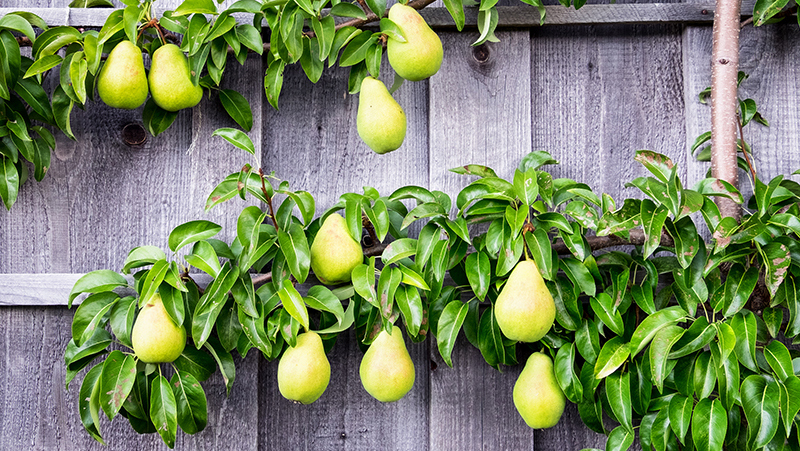Yates Account
Join now
Create a Yates account today!
Sign up to join the Yates Garden Club for monthly e-mails packed with seasonal inspiration, tips for success & exclusive promotions.
Plus if you’re a Garden Club member you can take part in the Yates Growing Community - a blog to share successes, get advice & win prizes in fun challenges along the way!

Forgot password
Enter the email address associated with your account, and we'll email you a new password.

Crisp slices of pear on a cheese platter, delicious pear tarts and cakes and refreshing savoury salads are just a few of the ways pears can be enjoyed. Pear trees (Pyrus communis) are wonderfully ornamental too and can reach heights between 2-4m. However, there are dwarf forms available that only grow to 1.5m tall and wide, perfect for smaller gardens and pots.
How to grow Pears in a garden
- Choose a sunny spot with well drained soil. Enrich the soil with Yates Dynamic Lifter Organic Plant Food. If the soil is clay based, improve soil structure by adding gypsum and forking in well.
- Dig the planting hole twice as wide and to the same depth as the root-ball. Remove the plant from the container, gently tease the roots and cut away any circled or tangled roots.
- Position in hole and backfill with soil, gently firming down. Form a raised doughnut shaped ring of soil around the outer edge of the plant's root zone. This helps keep water where it's needed. Always water in well after planting to settle the soil around the roots and keep the soil moist for several weeks while the new plant establishes.
- Mulch around the base with organic mulch like woodchip or pea straw, keeping it away from the trunk.
- Water deeply, once or twice a week, depending on weather conditions.
- During the growing and flowering/fruiting season, feed with Yates Thrive Citrus & Fruit Granular Plant Food. TIP: for an added boost during the flowering/fruiting season, apply Yates Thrive Natural Citrus & Fruit Plant Food Concentrate.

How to grow Pears in a pot
Pears can be grown in pots, but look for the dwarf varieties such as 'Garden Belle Dwarf'.
- Choose a pot at least 600mm wide - the larger the better. Position in full sun and fill with quality potting mix, such as Yates Premium Potting Mix.
- Remove the plant from the container, gently tease the roots and cut away any circled or tangled roots.
- Position in hole and backfill with potting mix, gently firming down. Water in well.
- Water deeply, 2-3 times during the week, depending on weather conditions.
- During the growing and flowering/fruiting season, feed weekly with Yates Thrive Citrus Liquid Plant Food. Throughout the year apply Yates Thrive Fish Blood & Bone Plant Food Concentrate.
Growing tips
- Most pear varieties will need at least two trees to help with pollination and fruit set. If you don’t have the space, look for self-fertile varieties such as ‘Conference’.
- Pears are also great for espaliering, a technique where trees are trained to grow flat against a wall or trellis thereby taking up very little room.
- Pears do best in cool to temperate zones, with different varieties requiring different levels of ‘chilling hours’ to maximise fruit yield. Ensure you check the label before purchasing to see if its suitable for your climate.
- For warmer areas look out for special ‘low chill’ varieties.
More Plants
Lemon trees can grow up to 4m, but you can also get dwarf varieties that only grow to 1.5m which are perfect for small gardens and for pots.
Feijoa
Feijoa trees are a familiar sight in kiwi gardens; they're also a great choice for an edible hedge. The delicious fruit can be eaten fresh; they’re also perfect for using in cakes, muffins, jams, cocktails, desserts, fruit salad and smoothies.
Raspberry
Raspberries are best when they're fresh, and you can’t get any fresher than picking your own! Delicious when eaten raw and in desserts, jam or jelly.
Limes
Lime fruits are known for their delicious juice and zest. A highly flavoursome ingredient used in sweet or savoury dishes and sensational in drinks.
Yates Thrive Citrus & Fruit Granular Plant Food
Fast acting, gradual feeding plant food specially formulated to grow citrus & fruit trees, with high potassium for more abundant fruit & added magnesium to help prevent leaf yellowing.
Yates Thrive Natural Citrus & Fruit Plant Food Concentrate
Specially developed for boosting healthy yields of juicy fruit in citrus & other fruiting plants. Feeds through both leaves and roots for fast results.
Yates Premium Potting Mix
A premium potting mix, ideal for all potted plants and shrubs, including ornamentals, fruit trees, vegies and herbs.
Yates Dynamic Lifter Organic Plant Food
Releases nutrients slowly, improves the structure and moisture retention of the soil and encourages earthworms and beneficial soil micro-organisms.
















Share
Share this article on social media